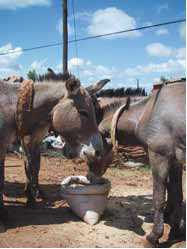Difference between revisions of "Protein Requirements - Donkey"
m (Protected "Protein Requirements - Donkey" [edit=sysop:move=sysop]) |
|||
| Line 1: | Line 1: | ||
{{review}} | {{review}} | ||
| + | |||
| + | [[Image:Donkeys fed bran.jpg|right|thumb|200px|<small><center>Where feed resources are poor, feeding donkeys a little extra food | ||
| + | in the form of crop by-products such as bran can help them survive harsh working conditions. Mineral licks should always be fed with these supplements to provide a balanced diet.(Image courtesy of [http://drupal.thedonkeysanctuary.org.uk The Donkey Sanctuary])</center></small>]] | ||
| + | Proteins are required by all living creatures for growth and repair of body tissues. They are polypeptide chains consisting of individual amino acids linked together. The properties of individual proteins are determined from the combination and number of different amino acids comprising the polypeptide chain. | ||
| + | |||
| + | Ten amino acids cannot be synthesised to any great degree by the body and must be supplied in food; these are referred to as the '''essential amino acids (EAA)'''. Proteins that contain a relatively high proportion of EAA are called high-quality proteins; low-quality proteins contain only small amounts of EAA. The requirement for certain EAA (lysine, cysteine and methionine) is much greater than others, and if the requirement for any one of these is not met in the diet, the ability of the animal to grow, recover from injury, lactate or reproduce will be severely limited, even if the other EAA are fed to excess. | ||
| + | |||
| + | In ruminants, another source of EAA is derived from the digestion of microbial protein that is produced as a by-product of fibre digestion. A similar process occurs in donkeys, although the microbial-derived EAA cannot be digested or absorbed before they are excreted in the faeces. However, the ability of donkeys to thrive and grow on the very low protein forages found in many tropical countries does provide some anecdotal evidence that processes of protein digestion and metabolism in donkeys are more complex than is currently perceived. | ||
| + | |||
| + | As a general rule, once the energy requirements of an animal are satisfied by the diet, then the protein requirements tend also to be satisfied. This has been confirmed by recent studies at the Donkey Sanctuary which measured the digestible crude protein (DCP) requirements for adult donkeys at 26 ± 1.3 g DCP per 100 kg bodyweight per day (Wood ''et al'', 2005). In practice, this amount of DCP would be comfortably supplied from the diet based on hay and ''ad libitum'' straw that was suggested in the [[Energy Requirements - Donkey|energy requirement section]]. | ||
| + | |||
| + | ==References== | ||
| + | |||
| + | * Smith, D. and Wood, S. (2008) Donkey nutrition In Svendsen, E.D., Duncan, J. and Hadrill, D. (2008) ''The Professional Handbook of the Donkey'', 4th edition, Whittet Books, Chapter 1 | ||
| + | * Wood, S.J., Smith, D.G., and Morris, C.J. (2005). ‘Seasonal variation of digestible energy requirements of mature donkeys in the UK’. ''Proceedings Equine Nutrition Conference'', Hanover, Germany. 1-2 October 2005. pp 39-40. | ||
Revision as of 13:34, 22 February 2010
| This article has been peer reviewed but is awaiting expert review. If you would like to help with this, please see more information about expert reviewing. |

Proteins are required by all living creatures for growth and repair of body tissues. They are polypeptide chains consisting of individual amino acids linked together. The properties of individual proteins are determined from the combination and number of different amino acids comprising the polypeptide chain.
Ten amino acids cannot be synthesised to any great degree by the body and must be supplied in food; these are referred to as the essential amino acids (EAA). Proteins that contain a relatively high proportion of EAA are called high-quality proteins; low-quality proteins contain only small amounts of EAA. The requirement for certain EAA (lysine, cysteine and methionine) is much greater than others, and if the requirement for any one of these is not met in the diet, the ability of the animal to grow, recover from injury, lactate or reproduce will be severely limited, even if the other EAA are fed to excess.
In ruminants, another source of EAA is derived from the digestion of microbial protein that is produced as a by-product of fibre digestion. A similar process occurs in donkeys, although the microbial-derived EAA cannot be digested or absorbed before they are excreted in the faeces. However, the ability of donkeys to thrive and grow on the very low protein forages found in many tropical countries does provide some anecdotal evidence that processes of protein digestion and metabolism in donkeys are more complex than is currently perceived.
As a general rule, once the energy requirements of an animal are satisfied by the diet, then the protein requirements tend also to be satisfied. This has been confirmed by recent studies at the Donkey Sanctuary which measured the digestible crude protein (DCP) requirements for adult donkeys at 26 ± 1.3 g DCP per 100 kg bodyweight per day (Wood et al, 2005). In practice, this amount of DCP would be comfortably supplied from the diet based on hay and ad libitum straw that was suggested in the energy requirement section.
References
- Smith, D. and Wood, S. (2008) Donkey nutrition In Svendsen, E.D., Duncan, J. and Hadrill, D. (2008) The Professional Handbook of the Donkey, 4th edition, Whittet Books, Chapter 1
- Wood, S.J., Smith, D.G., and Morris, C.J. (2005). ‘Seasonal variation of digestible energy requirements of mature donkeys in the UK’. Proceedings Equine Nutrition Conference, Hanover, Germany. 1-2 October 2005. pp 39-40.
|
|